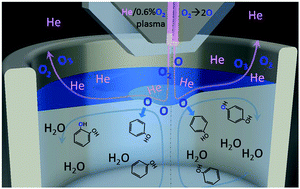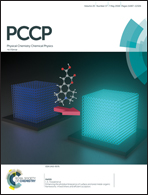The fate of plasma-generated oxygen atoms in aqueous solutions: non-equilibrium atmospheric pressure plasmas as an efficient source of atomic O(aq)†
Abstract
Non-equilibrium radio-frequency driven atmospheric-pressure plasma in He/0.6%O2 gas mixture has been used to study the reaction mechanism of plasma-generated oxygen atoms in aqueous solutions. The effluent from the plasma source operated with standard and 18O-labeled O2 gas was used to treat water in the presence of phenol as a chemical probe. Comparing the mass spectrometry and gas chromatography-mass spectrometry data of the solutions treated with plasma under normal and labeled oxygen provides clear evidence that O(aq) originating from the gas phase enters the liquid and reacts directly with phenol, without any intermediate reactions. Additionally, the atmospheric-pressure plasma source demonstrates great potential to be an effective source of O(aq) atoms without the requirement for any precursors in the liquid phase.



 Please wait while we load your content...
Please wait while we load your content...